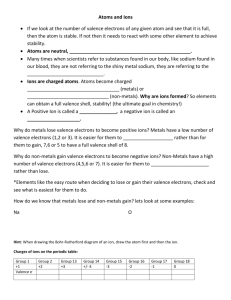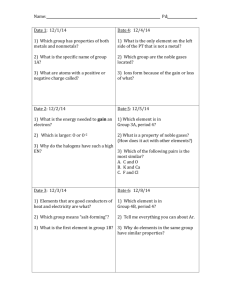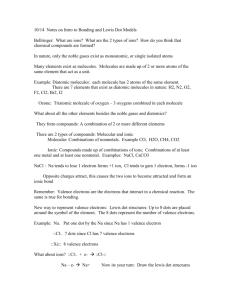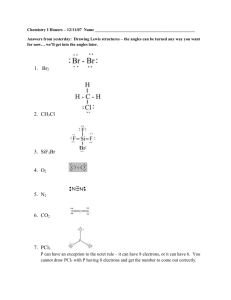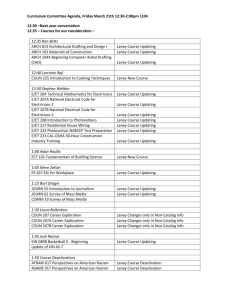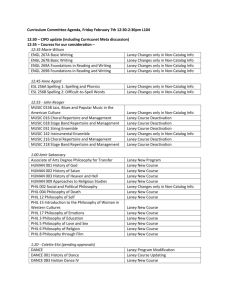Exam I spring 2014
advertisement
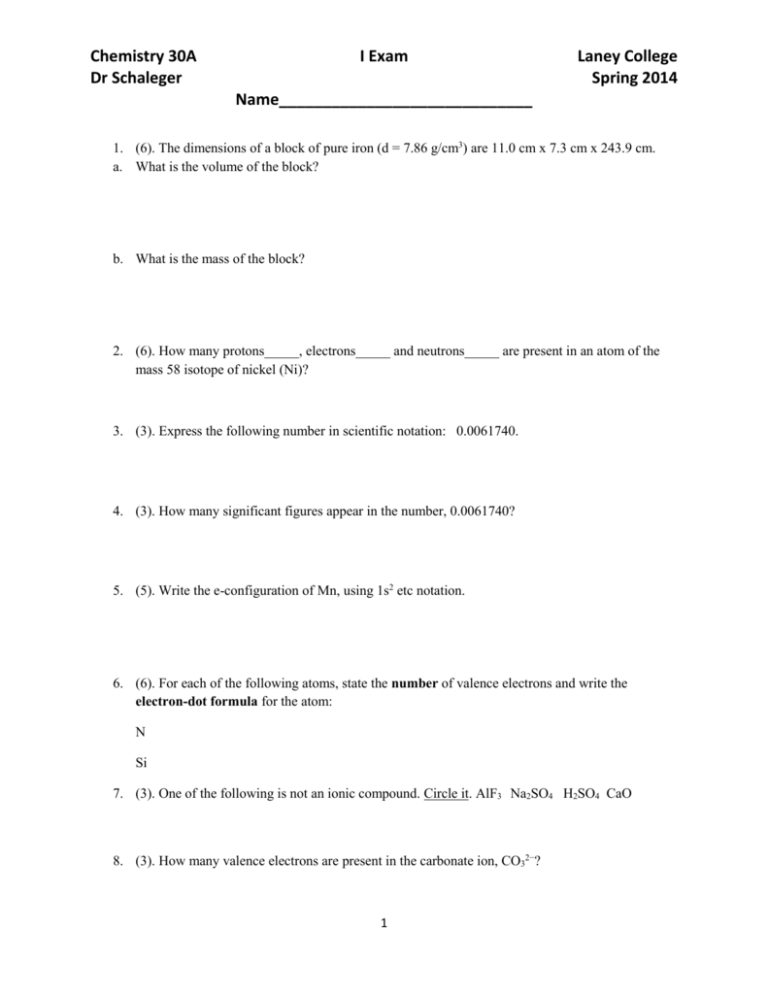
Chemistry 30A Dr Schaleger I Exam Laney College Spring 2014 Name_____________________________ 1. (6). The dimensions of a block of pure iron (d = 7.86 g/cm3) are 11.0 cm x 7.3 cm x 243.9 cm. a. What is the volume of the block? b. What is the mass of the block? 2. (6). How many protons_____, electrons_____ and neutrons_____ are present in an atom of the mass 58 isotope of nickel (Ni)? 3. (3). Express the following number in scientific notation: 0.0061740. 4. (3). How many significant figures appear in the number, 0.0061740? 5. (5). Write the e-configuration of Mn, using 1s2 etc notation. 6. (6). For each of the following atoms, state the number of valence electrons and write the electron-dot formula for the atom: N Si 7. (3). One of the following is not an ionic compound. Circle it. AlF3 Na2SO4 H2SO4 CaO 8. (3). How many valence electrons are present in the carbonate ion, CO32−? 1 Chemistry 30A Dr Schaleger I Exam Laney College Spring 2014 Name_____________________________ 9. (6). What is the most likely formula of the sulfide of Li? The oxide of Al? 10. (4). Write the e-configuration of the Cr+3 ion using arrow notation. 11. (3). The Al3+ ion has the same e-configuration as which noble gas? 12. (3). Given that 1 in = 2.54 cm, what is the number of feet in one meter? (In other words, calculate feet/meter). 13. (6). Using VSEPR theory, predict the geometric shapes of each of the following molecules (start by drawing the Lewis octet structure): a. NH3 b. CO2 14. (8). Draw the Lewis structure - showing all valence electrons – of phosphorus oxychloride, POCl3. (P is the central atom). Start by determining the number of valence electrons. 15. (9). Hydrogen chloride (HCl) is a gas that dissolves in water to give H+ ions (more correctly, H3O+ ions) and Cl− ions, generating considerable heat in the process. Is this a chemical change_____ or a physical change_____? Is the resulting solution homogeneous_____ or heterogeneous_____? Is the resulting solution acidic_____, basic_____ or neutral_____? 2 Chemistry 30A Dr Schaleger I Exam Laney College Spring 2014 Name_____________________________ 16. (5). Given that (9/5)C + 32 = F, what is the temperature in degrees F when it is 10.0 degrees Celsius? What is this temperature in Kelvins (K)? 17. (5). Calculate the specific heat of copper if it takes 23 cal to heat a 5.0 g sample from 25 0C to 75 0 C. (Caution: significant figures!). 18. (3) Group 1A metals easily gain an electron. True____ or false____. 19. (3) In the NaCl crystal lattice, each sodium ion has how many nearest-neighbor choride ions____? 20. (4) The ‘old’ name for MnO2 was manganese dioxide. An incorrectly written ‘new’ name is manganese(II) oxide. Give the correct ‘new’ name. 21. (3). Given that the electronegativities of H, C and O are 2.1, 2.5, and 3.0, which molecular bond is more polar, C-H _____or O-H _____? 22. (3). The maximum number of covalent bonds that nitrogen can form is 4. However phosphorus, which is also in Group 5A, can form 5 covalent bonds. What does phosphorus have that are not available to nitrogen? 3 Chemistry 30A Dr Schaleger I Exam Name_____________________________ SCORING 1. (6) _____ 2. (6) _____ PERFECT SCORE = 100 3. (3) _____ YOUR TOTAL_______ 4. (3) _____ CLASS MEDIAN _____ 5. (5) _____ YOUR ADJUSTED SCORE (%) _____ 6. (6) _____ LETTER GRADE _____ 7. (3) _____ 8. (3) _____ 9. (6) _____ 10. (4) _____ 11. (3) _____ 12. (3) _____ 13. (6) _____ 14. (8) _____ 15. (9) _____ 16. (5) _____ 17. (5) _____ 18. (3) _____ 19. (3) _____ 20. (4) _____ 21. (3) _____ 22. (3) _____ 4 Laney College Spring 2014


